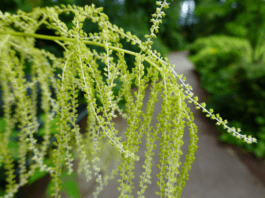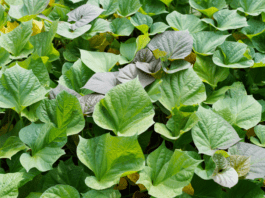FOXTAIL FERN
JUST as foxes are being sighted in suburbia, so is the foxtail fern, making something of a comeback.
An evergreen arching perennial has feathery-foliaged stems and, although not a true fern, can be grown from spores like those of a fern.
It produces small flowers in summer and later berries, but the foxtail-like stems are its appeal.
Asparagus Ferns
Related to the vegetable asparagus, it can be grown in a garden bed or hanging basket and is reasonably hardy. It does best in a part-sun, part-shade position and can grow up to a meter tall.
Asparagus ferns have been around for a long time, and many have enjoyed them as houseplants for years. They are dependable, easy-to-grow plants that can put on an attractive display of lovely foliage.
The attraction of asparagus ferns is their delicate, feathery foliage, produced on elongated, thick wiry stalks that begin by being upright but eventually become pendulous as they lengthen. These branches can be quite long, with few growing well over a meter in length.
The small leaves, which may be a couple of centimeters long but are only about a quarter of a centimeter wide, are produced along the stems in bunches and are bright green.
The foliage has given rise to the commonly accepted name for the plant, asparagus fern, even though it is not really a member of the asparagus plant family.
Asparagus Ferns Truth
Asparagus ferns are not really ferns either; they are actually members of the lily family and are native to Asia and South Africa.
They grow outdoors in tropical areas – we saw some used in outdoor plantings in Palm Springs while on our winter holiday — but they are not hardy in our region.
The most usual form of asparagus fern is Asparagus sprengeri, which produces the longest fronds that grow from the fleshy rhizomes and ball of fibrous roots that form the root system of these plants.
The plants have rampant root growth, and roots and rhizomes soon fill a pot, so this is one plant that will need to be repotted frequently.
Should the branches get too long and cascade down too far to be accommodated in the allotted space, they can be trimmed off, which will cause the stems to branch and become bushier.
Asparagus ferns are strong feeders and need to be fertilized frequently; the foliage becomes quite pale green if nutrients are lacking.
Asparagus Densiflorus – Foxtail Fern
Another variety of asparagus fern is Asparagus densiflorus, sometimes called the foxtail fern because of its unusually shaped fronds.
While the ordinary asparagus fern has a blousy, informal growth habit, the foxtail fern produces stems that are round in appearance because the leaves are attached to the stems all the way around the stems, which do looks like a fox’s round tail.
The foxtail fern also has shorter fronds and has a somewhat more upright growth habit, although the longer fronds do become pendulous. It is a most unusual-looking plant and is sure to elicit comments from observers.
All asparagus ferns prefer rich, well-drained soil; I have grown them successfully in a good quality soilless mix that is peat-based. Some people add some sand to the mix. These ferns also like their planting medium to be kept moderately moist and resent having it dry out.
The appearance of yellow leaves on an asparagus fern usually indicates that the soil is too dry. The yellow leaves will not recover and will, in fact, drop off the plant, so it is a good idea to prevent this from happening by not allowing the soil to become too dry.
Asparagus ferns in our area are usually grown indoors, where they make good house plants. In the last couple of years, they have been used increasingly outdoors in containers — in particular, Asparagus sprengeri is used in this way.
Often used as a filler in a large container of plants, the asparagus fern’s foliage acts as a foil for the other more colorful plants in the container.
It also may be used by itself in a hanging basket, but whatever way it is used, the planting location must be high enough to accommodate its long pendulous branches.
Indoors, asparagus ferns will get along with some direct sun, particularly in the winter months, but they will perform well in bright indirect light as well. Outdoors should be protected from the strongest rays of the mid-day sun but will be happy to receive some direct sun.
Therefore, the asparagus fern is a plant that can serve a dual purpose: it can be a houseplant in the off-season and contribute to the outdoor landscape in the summertime.
If you see one of these plants at a garden center, you might want to pick one up to add to your indoor landscape with the view of using it in one of your outdoor containers when spring arrives.





